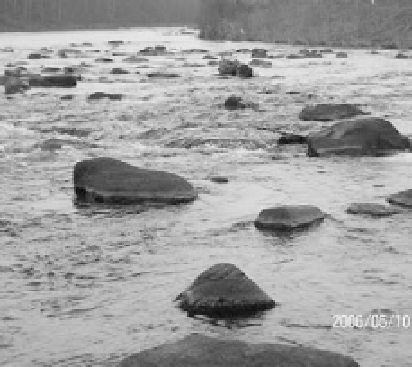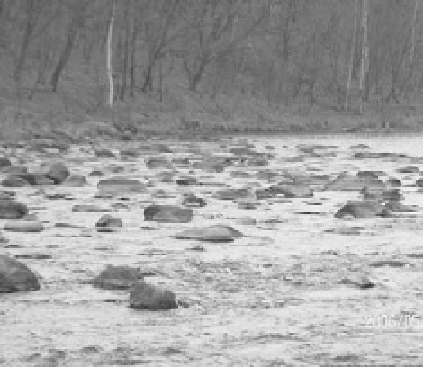Environmental Engineering Reference
In-Depth Information
channel including the deepest part of the channel, as shown in Fig. 3.39. The randomly distributed
boulders on the channel bed create a high and uniform resistance throughout the channel bed, and, thus,
consume the energy of the flow and form a stable channel bed. The reaches with the star-studded
boulders are about 200 500 m long, and there are reaches 0.5 3 km long with a gravel bed and deep
water between every two reaches with the star-studded boulders. The slope in the reaches with the
star-studded boulders is about two times of the slope of the reaches with a gravel bed. Figure 3.39 shows
two reaches with star-studded boulders.
Fig. 3.39
Two reaches with the star-studded boulders in the Balan River in northeastern China
3.3.3.3
Bank Stones
Bank stones structures are simple self-developed structures of incised rivers for protection of the banks.
Figure 3.40(a) shows the bank stone structure on the Dadu River in Sichuan Province. Boulders of
diameter larger than 1 m line on the two side of the channel and increase the bank roughness. Thus, the
flow velocity is reduced near the banks and high velocity current cannot assault the banks. The bank
stones structure effectively controls bank erosion and protects the Danba County Town. Figure 3.40(b)
shows the bank stones in the 200 m wide Jialing River, a tributary of the Yangtze River in southwestern
China. Boulders and stones are transported from the nearby tributaries and gullies and line the banks.
The structure reduces the current velocity and enhances the stability of the channel.
3.3.3.4
Boulder and Cobble Clusters
Boulder and cobble clusters are accumulations of sediment on either (or both) the lee and the stoss side
of an obstacle clast in rivers with poorly sorted sediments (Wittenberg, 2002a). These bed forms are
considered to develop periodically during the falling stage of high flow events under rapid turbulent flow.
Cluster bed forms are the most prevalent type of small-scale bed forms in gravel-bed rivers and
contribute to roughness properties and the enhanced bed stability. Figure 3.41(a) shows the boulder
clusters in the Baohe River, a tributary of the Hanjiang River and Fig. 3.41(b) shows the cobble clusters
with a shape of a diamond in the Golden Whip Brook in the Xiangjiang River basin in Central China.
Sear (1992) and Sohag (1993) used a dynamic penetrometer to set bed stability criteria in relation to
the bed strength exerted by different structural arrangements of bed particles. Sear (1996) found that
clusters, especially obstacle clasts, wake and stoss accumulations, are among the most resistant
configurations of a gravel riverbed to entrainment. Shear stress required to entrain clustered sediments is
higher than that required for entraining open bed particles (Brayshaw, 1985; Reid., 1992; James, 1993;



Search WWH ::

Custom Search